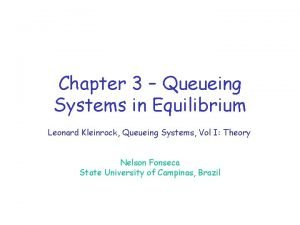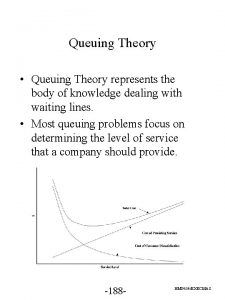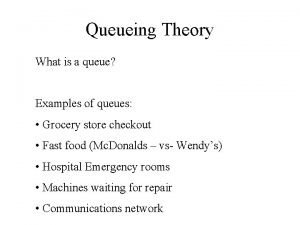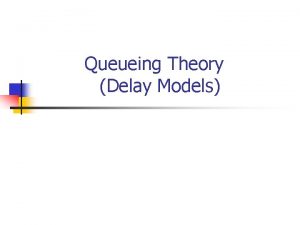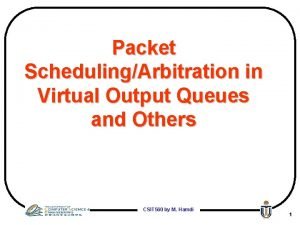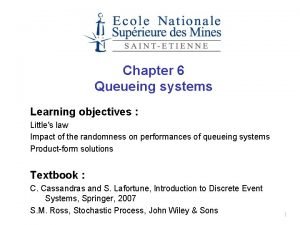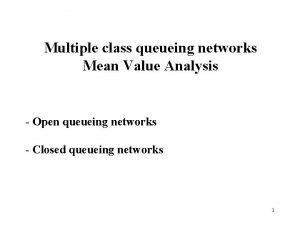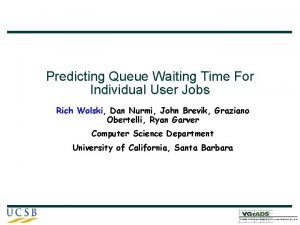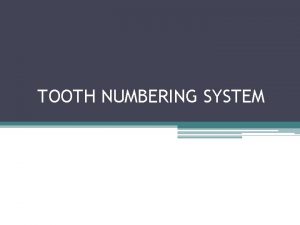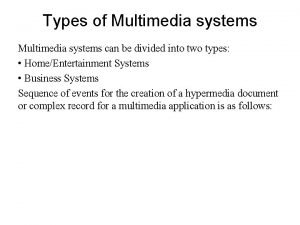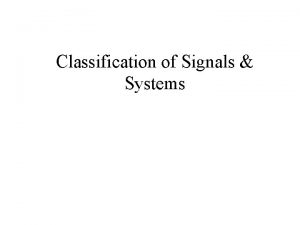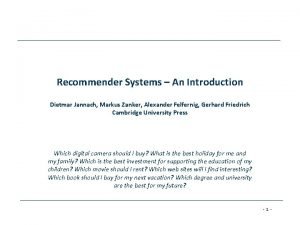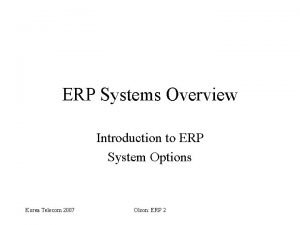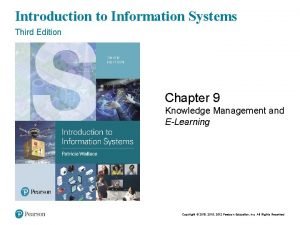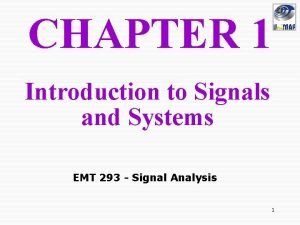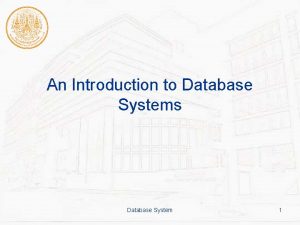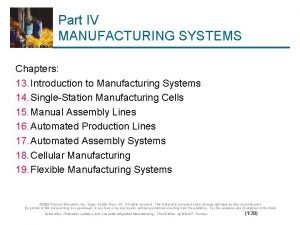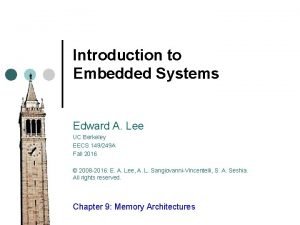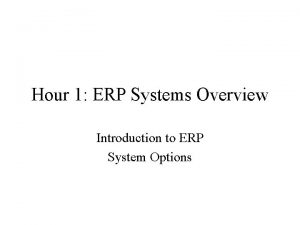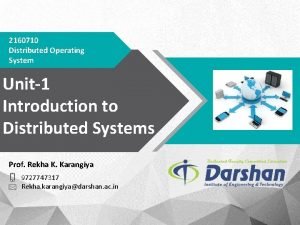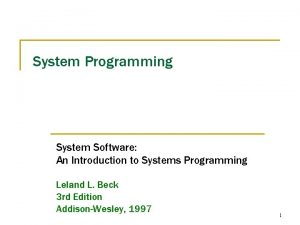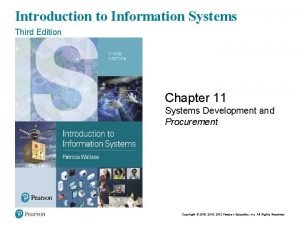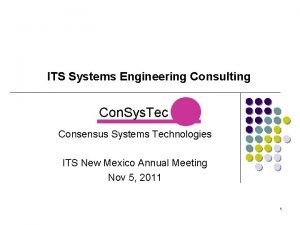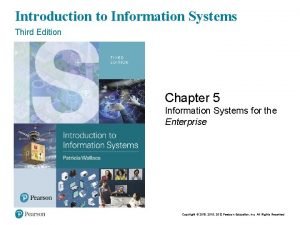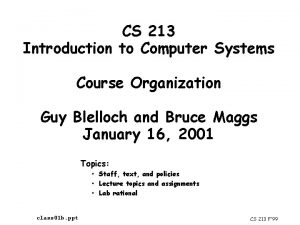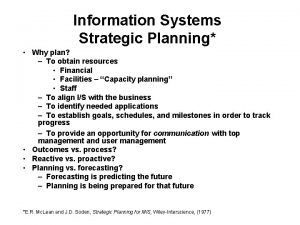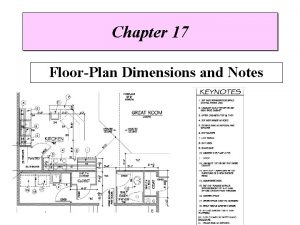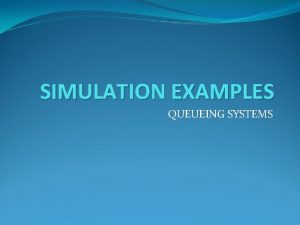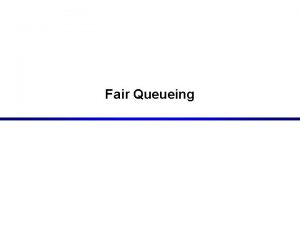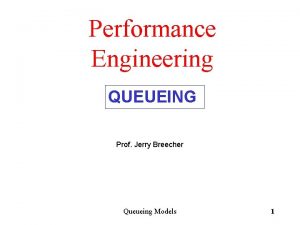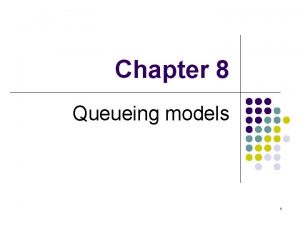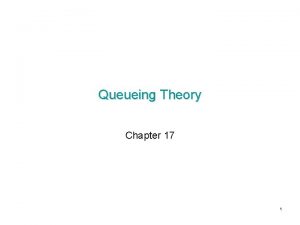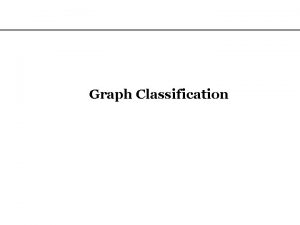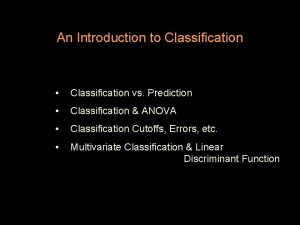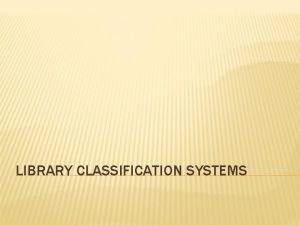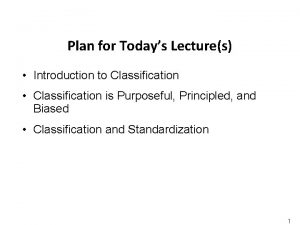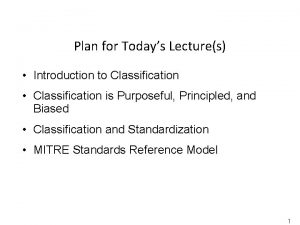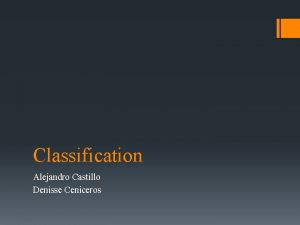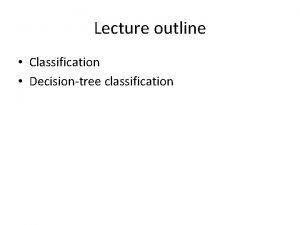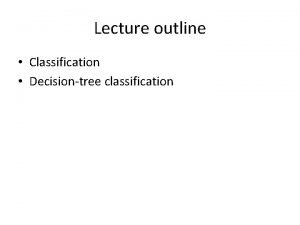Queueing systems 1 Plan Introduction Classification of queueing








































![G/G/1 queue • Inter-arrival times An between customer n and n+1 : E[An] = G/G/1 queue • Inter-arrival times An between customer n and n+1 : E[An] =](https://slidetodoc.com/presentation_image_h2/fa1abdf4ae807329df6110d80e5e0527/image-41.jpg)




























- Slides: 69

Queueing systems 1

Plan • • • Introduction Classification of queueing systems Little's law Single stage queuing systems Queuing networks 2

Introduction 3

Definition of a queueing system Departure of served customers Customer arrivals Departure of impatient customers • A queueing system can be described as follows: "customers arrive for a given service, wait if the service cannot start immediately and leave after being served" • The term "customer" can be men, products, machines, . . . 4

History of queueing theory • The theory of queueing systems was developed to provide models forecasting behaviors of systems subject to random demand. • The first problems addressed concerned congestion of telephone traffic (Erlang, "the theory of probabilities and telephone conversations ", 1909) • Erlang observed that a telephone system can be modeled by Poisson customer arrivals and exponentially distributed service times • Molina, Pollaczek, Kolmogorov, Khintchine, Palm, Crommelin followed the track 5

Interests of queueing systems Queueing theory found numerous applications in: – Trafic control (communication networks, air traffic, …) – Planing (manufacturing systems, computer programmes, …) – Facility dimensioning (factories, . . . ) 6

Classification of queueing systems 7

Characteristics of simple queueing systems Queueing systems can be characterized with several criteria: • • • Customer arrival processes Service time Service discipline Service capacity Number of service stages 8

Notation of Kendall The following is a standard notation system of queueing systems T/X/C/K/P/Z with – T: probability distribution of inter-arrival times – X: probability distribution of service times – C: Number of servers – K: Queue capacity – P: Size of the population – Z: service discipline 9

Customer arrival process T/X/C/K/P/Z • T can take the following values: – M : markovian (i. e. exponential) – G : general distribution – D : deterministic – Ek : Erlang distribution –… • If the arrivals are grouped in lots, we use the notation T[X] where X is the random variable indicating the number of customers at each arrival epoch – P{X=k} = P{k customers arrive at the same time} • Some arriving customers can leave if the queue is too long 10

Service times T/X/C/K/P/Z • X can take the following values: – M : markovian (i. e. exponential) – G : general distribution – D : deterministic – Ek : Erlang distribution –… k exponential servers with parameter m Erlang distribution Ek with parameter m 11

Number of servers T/X/C/K/P/Z In simple queueing systems, servers are identical 12

Queue capacity T/X/C/K/P/Z Loss of customers if the queue is full Capacity K 13

Size of the population T/X/C/K/P/Z The size of the population can be either finite or infinite For a finite population, the customer arrival rate is a function of the number of customers in the system: l(n). 14

Service discipline T/X/C/K/P/Z Z can take the following values: • FCFS or FIFO : First Come First Served • LCFS or LIFO : Last Come First Served • RANDOM : service in random order • HL (Hold On Line) : when an important customer arrives, it takes the head of the queue • PR ( Preemption) : when an important customer arrives, it is served immediately and the customer under service returns to the queue • PS (Processor Sharing) : All customers are served simultaneously with service rate inversely proportional to the number of customers • GD (General Discipline) 15

The concept of customer classes A queueing system can serve several classes of customers characterized by: • different arrival processes • different service times • different costs • service priority according to their class (preemption or no for example) 16

Simplified notation We will use the simplified notation T/X/C when we consider a queue where: • The capacity is infinite • The size of the population is infinite • The service discipline is FIFO • Hence T/X/C = T/X/C/ / /FIFO 17

Ergodicity • A system is said ergodic if its stationary performances equal the time average of any realisation of the system, observed over a sufficiently long period • A regenerative system, i. e. a system with a given state s 0 that is visited infinitely often, is ergodic. • Finite, irreducible and aperiodic CMTC are ergodic. • Only ergodic systems will be considered in this course 18

Ergodicity • A non ergodic system : X(t) = reward of the state at time t 1 1 2 unit reward 1 5 unit reward 2 1 1 1 3 4 19

Little's law 20

Some transient performances THe(T) L(T) THs(T) W(T) • A(T) : number of customers arrived from 0 to T • D(T) : number of departures between 0 to T • THe(T) = A(T)/T : average arrival rate between 0 to T • THs(T) = D(T)/T : average departure rate between 0 to T • L(T) : average number of customers between 0 to T • Wk: sojourn time of k-th customer in the system • average sojourn time between 0 to T 21

Stability of the queueing system THe(T) Queueing system THs(T) Definition : A queueing system is said stable if the number of customers in the system remains finite. Implication of the stability: 22

Little's law For a stable and ergodic queueing system, L = TH×W where • L : average number of customers in the system • W : average response time • TH : average throughput rate Queueing system TH L W TH 23

Proof e(T) 24

Proof where N(T) is the number of customers at time T, e(T) total remaining system time of customers present at time T. Letting T go to infinity, the stability implies the proof. 25

Single stage queueing systems 26

M/M/1 queue N(t) : number of customers in the system l Poisson arrivals Exponentially distributed service tim 27

Stability condition of M/M/1 queue The M/M/1 queue is stable iff l<m or equivalently r<1 where • r = l/m is called the traffic ratio or traffic intensity. The number of customers in the system is unlimited and hence there is no steady state when the system is not stable. 28

Markov chain of the M/M/1 queue When the system is stable, stationary probability distribution exists as the CTMC is irreducible. Let 29

Steady state distribution of M/M/1 queue With r = l/m, p 0 = 1 - p pn = rn p 0 30

Performance measures of M/M/1 queue (online proof and figures) Ls = Number of customers in the queue = r/(1 -r) = l/(m-l) Ws = Sojourn time in the system = 1/(1 -r)m = 1/(m-l) Lq = queue length = l 2/(m-l)m = Ls - r Wq = average waiting time in the queue = l/(m-l)m = Ws - 1/m TH = departure rate = l Server utilization ratio = r Server idle ratio = P 0 = 1 - r P{n > k} = Probability of more than k customers = rk+1 31

M/M/C queue Exponentially distributed service tim l Poisson arrivals N(t) : number of customers in the system N(t) is a birth and death process with • The birth rate l. • The deadth rate is not constant and is equal to N(t)m if N(t) C and Cm if N(t) > C. Stability condition : l< cm. 32

Steady state distribution of M/M/C queue Distribution : r= l/m pn = rn/n! p 0, " 0 < n C Markov chain of M/M/2 queue 33

Performance mesures of M/M/C queue Ls = Number of customers in the system = Lq + r Ws = Sojourn time in the system = Wq + 1/m Lq = Average queue length = Wq = Average waiting time = Lq / l p = Average number of busy server, p = r U = Waiting probability = p. C + p. C+1 +. . . = p. C/(1 -r/C) 34

M/M/C with impatient customers • Similar to M/M/C queue except the loss of customers which arrive when all servers are busy. Markov chain of M/M/2 queue with impatient customers 35

M/M/C with impatient customers Steady state distribution : r = l/m Pn = rn/n! P 0, " 0 < n C Pourcentage of lost customers = PC Server utilization ratio = (1 – PC) l/Cm Insensitivity of Erlang Loss system M/GI/C without queue (see Gross & Harris or S. Ross, proof by reserved system) : Pn depends on the distribution of service time T only through its mean, i. e. with m = E[T] 36

M/G/1 queue Poisson arrival Service time Ts 37

M/G/1 queue As the service time is generally distributed, the departure of a customer depar depends on the time it has been served. The stochastic process N(t) is not a Markov chain. 38

M/G/1 queue: an embeded Markov chain • Consider the stochastic process {Xk}k≥ 1 , the number of customers after the departure of the k-th customer at tk 4 arrivals {Xk}k≥ 1 is a CTMC and Xk+1 = (Xk -1)+ + number of customers arrived during the service of the (k+1)-th customer. Distribution of {Xk} is also the steady state distribution. 39

M/G/1 queue: Pollaczek-Khinchin formula • Pollaczek-Khinchin formula or PK formula • From the PK formula, other performance measures such as Ws, Lq, Wq can be easily derived. • From PK formula, we observe that randomness always hurt the performances of a system. The larger the randomness (i. e. larger cv 2), the longer the queue length is. 40
![GG1 queue Interarrival times An between customer n and n1 EAn G/G/1 queue • Inter-arrival times An between customer n and n+1 : E[An] =](https://slidetodoc.com/presentation_image_h2/fa1abdf4ae807329df6110d80e5e0527/image-41.jpg)
G/G/1 queue • Inter-arrival times An between customer n and n+1 : E[An] = 1/l • Service time Tn of customer n : E[Tn] = 1/m • Waiting time Wn in the queue of customer n (Lindley equation) Wn+1 = max{0, Wn + Tn - An} 41

G/G/1 queue • Bounds of Waiting time • If E[A - t | A > t] < 1/l, then tightless check with Lq • Waiting time approximation (Kingman's equation or VUT equation) Varability Utilization Time 42

Queueing networks 43

Definition of queueing networks A queueing network is a system composed of several interconnected stations, each with a queue. Customers, upon the completion of their service at a station, moves to antoher station for additional service or leave the system according some routing rules (deterministic or probabilitic). 44

Example of deterministic routing Shortest queue rule 45

Open network or closed network Open network N customers Closed network 46

Multi-class network 47

A production line Raw parts Finished parts 48

Open Jackson Network An open Jackson network (1957) is characterized by: • • One single class of customers A Poisson arrival process at rate l (equivalent to independent external Poisson arrival at each station) One server at each station Exponentially distributed service time with rate mi at station i Unlimited capacity at each queue FIFO service discipline at all queues Probabilistic routing 49

Open Jackson Network routing • pij (i ≠ 0 and j≠ 0) : probability of moving to station j after service at station i • p 0 i : probability of an arriving customer joining station i • pi 0 : probability of a customer leaving the system after service at station i 50

Open Jackson Network stability condition • Let li be the customer arrival rate at station i, for i = 1, . . . , M where M is the number of stations. • The system is stable if all stations are stable, i. e. li < mi, "i = 1, . . . , M • Consider also ei the average number of visits to station i for each arriving customer: ei = li/l 51

Open Jackson Network arrival rate at each station • These arrival rates can be determine by the following system of flow balance equations which has a unique solution. Example: ? ? ? 52

Open Jackson Network Are arrivals to stations Poisson? as the departure process of M/M/1 queue is Poisson. Feedback keeps memory. 53

Open Jackson Network State of the queueing network • Let n(t) = (n 1(t), n 2(t), …, n. M(t)), where ni(t) is the number of customers at station i at time t • The vector n(i) describes entirely the state of the Jackson network • {n(t)}t≥ 0 is a CTMC • Let p(n) be the stationary probability of being in state n • Notation: ei = (0, …, 0, 1, 0, …, 0) i-th position 54

Open Jackson Network Underlying Markov Chain Attention: Some transitions are not possible when ni = 0, for some i 55

Open Jackson Network Stationary distribution - Product form solution Theorem: The stationary distribution of a Jackson queueing network has the following product form : where pi(ni) is the stationary distribution of a M/M/1 queue with arrival rate li and service rate mi, i. e. 56

Open Jackson Network Performance measures of each M/M/1 queue Performance measures of the queueing network 57

Open Jackson Network Extension to multi-server stations • Assume that each station i has Ci servers • The stability condition is li < Cimi, "i = 1, …, M • The stationary probability distribution still has the product form: where pi(ni) is the stationary distribution of a M/M/Ci queue with arrival rate li and service rate mi. 58

Open Jackson Network Proof of the product form solution Reversed Markov chain of a Markov chain is obtained by looking back in time. Transition rates m*ij are defined such that pim*ij = pjmji where mij and pi are transition rates and stationary distribution of the original CTMC. From the balance eq, Sj m*ij = Sj mij (same state sojourn time) Theorem of reversed CTMC: For an irreducible CTMC, if we can find a collection of numbers m*ij and a collection of numbers xi ≥ 0 summing to unity such that xim*ij = xjmji and Sj m*ij = Sj mij then m*ij are the transition rates of the reversed chain and xi are the steady state probabilities for both chains. (Home work) 59

Open Jackson Network Proof of the product form solution Guessed Reversed Markov chain of the Jackson network : a Jackson network with (1) arrival rate at station i including 0 : l*i = li (2) prob. of joining station j after service at i : l*ip*ij = ljpji or p*ij = ljpji/li (3) service rate at station i : m*i = mi Guessed Probability distribution to prove : 60

Open Jackson Network Proof of the product form solution Checking conditions of the reversed CTMC theorem 1/ Same sojourn time at the same state at any state n Trivial as l*0 = l 0 and m*i = mi ; 2/ xnm*n, n' = xn'mn', n for all couple of states n, n'. Case n = (n 1, . . . , ni, …, n. M) and n' = (n 1, . . . , ni+1, …, n. M) m*n, n' = l*0 p*0 i = lipi 0; mn', n = mipi 0 Case n = (n 1, . . . , ni, …, , nj, . . . , n. M) and n' = (n 1, . . . , ni+1, …, , nj-1, . . . , n. M) m*n, n' = m*jp*ji = mjlipij/lj; mn', n = mipij Case n = (n 1, . . . , ni, …, n. M) and n' = (n 1, . . . , ni-1, …, n. M) m*n, n' = m*ip*i 0 = milp 0 i/li; mn', n = lp 0 i Hence, x(n) is the distribution of the Jackson network. 61

Closed Queuing Network Definition • Similar to Jackson network but • with a finite population of N customers • without extern arrivals. As a result, • l=0 • • 62

Closed Queuing Network Arrival rates • The arrival rates li satisfy the following flow balance equations • Unfortunately, the above system of flow balance equations has one free variable. 63

Closed Queuing Network Product form solution of Gordon and Newell (1967) where • ri = li/mi with li obtained from the solution of the flow balance equations with a free constant chosen arbitrarily • C(N) is a normalizing constant such that the sum of probability equals 1, i. e. Direct computation of C(N) is very tedious when the state space is large. 64

Closed Queuing Network Computation of the normalization constant C(N) Buzen's algorithm (1973) uses relations (home work) Ci(k) = Ci-1(k) + ri. Ci(k-1), "i=2, . . . , M, k = 2, . . . , N where with initial conditions C 1(k) = (r 1)k, Ci(1) = 1 from which C(N) is obtained as C(N) = CM(N) 65

Closed Queuing Network Computation of the normalization constant C(N) It can be shown that the utilization of station i is given by The marginal distribution can be determined as follows (home work): 66

Closed Queuing Network Mean Value Analysis (MVA) • Suppose we are only interested in throughput THi and mean number of customers at station i Li (i. e. Lsi)and mean system time Wi (i. e. Wsi) • The MVA method of Reiser and Lavenberg (1980) bypasses te computation of C(N). • It relies on the following simple relations : where is the average system time experienced by a customer arriving at i is the average queue length seen by a customer arriving at i li is any solution of the flow balance equation a. N is the missing factor. 67

Closed Queuing Network Mean Value Analysis (MVA) • It can be shown that is the same as the average queue length at i in a network with (N-1) customers. • Let Li(N), THi(N), Wi(N) be the queue length, the throughput and the system time of a network with N customers. • The following system can be iteratively solved to obtain the results: where equation (4) is from Little's law for station i. • At each iteration N = 1, 2, . . . , (1) is used to determine Wi(N), combination of (3) & (4) determines a. N and THi(N), (4) gives Li(N). 68

Closed Queuing Network Example p m 2 1 -p m 3 m 1 p = 0. 5, m 1 = 4, m 2 = 1, m 3 = 2 N= 2, 3, 4 69
 Kleinrock queueing systems
Kleinrock queueing systems Queueing theory
Queueing theory Queueing theory
Queueing theory Queuing theory examples
Queuing theory examples Virtual output queueing
Virtual output queueing Kingmans formula
Kingmans formula Queueing
Queueing Predictive queueing
Predictive queueing Decision support systems and intelligent systems
Decision support systems and intelligent systems Engineering elegant systems: theory of systems engineering
Engineering elegant systems: theory of systems engineering Embedded systems vs cyber physical systems
Embedded systems vs cyber physical systems Elegant systems
Elegant systems Dental formula for deciduous teeth
Dental formula for deciduous teeth Classification of multimedia systems
Classification of multimedia systems Classification of signals and systems
Classification of signals and systems Medium risk examples
Medium risk examples Why do classification systems change over time?
Why do classification systems change over time? Classification systems _____.
Classification systems _____. Introduction to system analysis and design
Introduction to system analysis and design Introduction to recommender systems
Introduction to recommender systems Recommender systems: an introduction
Recommender systems: an introduction Introduction to operating systems
Introduction to operating systems Levels of ecological organization
Levels of ecological organization Systems applications and products
Systems applications and products Introduction to radar systems 3rd edition pdf
Introduction to radar systems 3rd edition pdf Introduction of health care delivery system
Introduction of health care delivery system Introduction to information systems 6th edition
Introduction to information systems 6th edition Introduction to erp systems
Introduction to erp systems Content management system features
Content management system features Fundamentals of information systems chapter 1
Fundamentals of information systems chapter 1 The term multimedia
The term multimedia Introduction to information systems 3rd edition
Introduction to information systems 3rd edition Introduction to information systems 5th edition
Introduction to information systems 5th edition Pxdes
Pxdes Introduction to signals and systems
Introduction to signals and systems Introduction to ems
Introduction to ems Components of information systems
Components of information systems Accounting information system chapter 1
Accounting information system chapter 1 An introduction to database systems
An introduction to database systems Introduction to global systems
Introduction to global systems Refrigeration and air conditioning ppt
Refrigeration and air conditioning ppt Introduction to manufacturing systems
Introduction to manufacturing systems Introduction to embedded systems lee seshia solution manual
Introduction to embedded systems lee seshia solution manual Introduction to electrical power systems
Introduction to electrical power systems Erp system options and selection methods
Erp system options and selection methods Classification of distributed system
Classification of distributed system System software: an introduction to systems programming
System software: an introduction to systems programming Advantages of digital computers
Advantages of digital computers Introduction to digital systems ercegovac pdf
Introduction to digital systems ercegovac pdf Cit593
Cit593 Introduction to low voltage systems
Introduction to low voltage systems Introduction to information systems 3rd edition
Introduction to information systems 3rd edition Introduction to digital control system
Introduction to digital control system 15-213 introduction to computer systems
15-213 introduction to computer systems Systems engineering consulting firms
Systems engineering consulting firms Introduction to information systems 3rd edition
Introduction to information systems 3rd edition 15-213 introduction to computer systems
15-213 introduction to computer systems Systems integration plan
Systems integration plan Information systems plan
Information systems plan Systems based plan
Systems based plan Eager learner vs lazy learner
Eager learner vs lazy learner Simple classification and manifold classification
Simple classification and manifold classification Traditional classification vs modern classification
Traditional classification vs modern classification Classification of computer
Classification of computer Lesson plan on classification
Lesson plan on classification Classification of nagpur road plan
Classification of nagpur road plan Classification of roads by nagpur road plan
Classification of roads by nagpur road plan Body paragraph structure
Body paragraph structure Floor plan introduction
Floor plan introduction Floor plan closet symbol
Floor plan closet symbol
